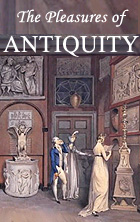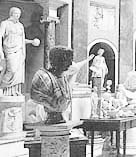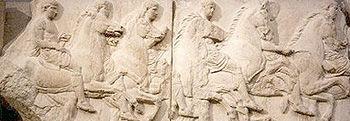The Pleasures of Antiquity
Jonathan Scott's erudite account of the re-migration of sculpture collections from America to Britain is packed with information on the antiquities trade. It also brings to life the flawed obsessions of our greatest private collectors.


This country contained the finest private collections of antique sculpture in Europe 150 years ago. In the following century many collections migrated to exotic locations in America; a one-way traffic which is still in motion.
The story of how Classical sculptures were shipped back to England in the era of the grand tour has only recently been studied again.

Private Collections in British Houses
Jonathan Scott has produced an erudite and comprehensive piece, marshalling well-known characters such as the Earl of Arundel and Lord Leicester of Holkham into an incisive history.
He fleshes the book out with moreobscure figures like the youthful Talbot, whose statues remained in their packing cases for fifteen years, and includes William Stukley's vignette of the 8th Earl of Pembroke, moving restlessly through his scultpure-crammed rooms:

'So that you may suppose that he generally walks 10 miles a day in his own house and sometimes in his Slippers and sometimes is so busy that unless Ladies come to visit him he will fob off his beard (as he calls it) for two or three days.'
Sign up for the Country Life Newsletter
Exquisite houses, the beauty of Nature, and how to get the most from your life, straight to your inbox.
The Pleasures of Antiquityis packed with new information, on the mechanics of the antiquities trade, its transactions, dealers and values and economics.
An important distinction is drawn between collectors for whom antiques were costly architectural props, and the painstaking efforts of a later generation.
Scott frequently reminds us how all these men were deceived by flawed history and the fictions of the dealers who literally put together their collection.

Why Did These Elgin Marbles Chase Off the Competition?
He concludes by wondering why our reverence for the Elgin Marbles has resulted in neglectfor superb Roman statues, an anomaly which this marvellous book will surely serve to remedy.
Country Life is unlike any other magazine: the only glossy weekly on the newsstand and the only magazine that has been guest-edited by HRH The King not once, but twice. It is a celebration of modern rural life and all its diverse joys and pleasures — that was first published in Queen Victoria's Diamond Jubilee year. Our eclectic mixture of witty and informative content — from the most up-to-date property news and commentary and a coveted glimpse inside some of the UK's best houses and gardens, to gardening, the arts and interior design, written by experts in their field — still cannot be found in print or online, anywhere else.
-
 380 acres and 90 bedrooms on the £25m private island being sold by one of Britain's top music producers
380 acres and 90 bedrooms on the £25m private island being sold by one of Britain's top music producersStormzy, Rihanna and the Rolling Stones are just a part of the story at Osea Island, a dot on the map in the seas off Essex.
By Lotte Brundle
-
 'A delicious chance to step back in time and bask in the best of Britain': An insider's guide to The Season
'A delicious chance to step back in time and bask in the best of Britain': An insider's guide to The SeasonHere's how to navigate this summer's top events in style, from those who know best.
By Madeleine Silver